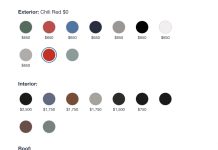I was hung up for a few weeks, waiting (after looking) for the parts I needed to rebuild the S3 donor bike’s disc brake system, which was thoroughly gunked up thanks to years of just sitting. It took me two days of intermittent fiddling just to get the caliper disassembled. One of the pads had literally fused to the mounting block and the original piston was seized in the bore. 
Luckily, the aftermarket makes replacement (and stainless steel) pistons for the S3 caliper. Not so luckily, the little metal ring that secures the rubber dust boot – as well as the dust boot itself, are both specific to the S3 and not the same as the more readily available brake rebuild parts for the similar H2 caliper. 
The goods news in my case is that both of my original parts were still usable, although the metal snap ring was pretty badly pitted from moisture contamination. I used a wire brush and drill to clean off the surface and then coated the ring with POR-15, same stuff I used on the inside of the rear brake drum. It seals the part and leaves a ceramic-like finish that’s extremely tough and durable.
I also was fortunate as far as the aluminum castings for the brake caliper. These pieces were in good shape, even including the “red dot” insert on the caliper’s face. This is available on the aftermarket, too – but I am glad I was able to use my original. It’s not 100 percent perfect, with some fade showing – but to me, this adds to the patina I am trying to create. 
Another mild deviation from stock is the stainless steel bleeder valve, which along with a number of other crucial and hard-to-find parts I acquired from Kawasaki Triple Parts in the UK. Simon, the owner, is a top-drawer guy and a triple maniac who has been extremely helpful during this process. 
I also got a very nice reproduction master cylinder assembly from him. My original had passageways as clogged as Bill Clinton’s arteries. Rebuildable? Probably – but given the availability of a near-perfect replacement, I decided to save myself some grief.The only thing about the repro that wasn’t quite right was the fill cap, which was just plain black. But I fixed this easily enough by swapping on my very nice original – with the imprinted cautions still very clear – after replacing the rubber boot underneath with a fresh one. 
All the lines are brand-new, too – including the metal hard line that connects the flexible soft line from the triple clamp to the caliper. My attitude on this is that it’s not worth chancing the integrity (and internal cleanliness) of old brake lines, especially if they’re on a bike that’s just been sitting for several years. A complete three-piece replacement cost me less than $50 and will assure that I don’t immediately contaminate my just-rebuilt caliper and brand-new master cylinder with the accumulated gunk of the past 30-plus years that might have been clinging to the insides of those original lines. Plus, it’s a safety issue. They may look ok outside, but trusting your life to 30-year-old rubber brake lines is not my idea of good policy. 
So, here’s a picture of the rebuilt caliper, installed on the rotor. The final steel line from the caliper to the rubber hose needs a little careful bending to get the angles just right but it should be in place shortly. Then, it’s just a matter of filling the system with fresh fluid and purging the air. I plan to use DOT 5 silicone fluid as it is much less susceptible to water contamination, so the new parts should last longer even though I will still change out the fluid regularly regardless. Most bike service manuals I’ve read advise doing a complete flush at least every two years. 
So, that completes everything except the engine and the bodywork. The tank, side covers and tail section are already at the paintshop. This is one part of the resurrection I will not be handling myself. A man has got to know his limitations, and I am not a painter. Well, I’m not a good enough painter to get the results I want. There’s also the issue of the tank’s insides. Outside, it looked pretty good. No physical damage; no rust at all. But inside…. let’s just say it’s ugly. The previous owner not only left fuel in it – which sat for at least 5 years – but prior to that, someone had done a soul-glo job of sealing it and the material (along with rots of rust) is peeling badly. It looks like an old frying pan that someone cooked stuff in then left in the sink for awhile. Since I don’t want to feed the newly rebuilt engine rust flakes and plastic goo, I am having the tank professionally scoured before it’s resealed, then painted – along with the other body parts. The shop says it will take about 5-6 weeks. It will be worth the wait to see the bodywork as new again, resplendent in the original Halibut Blue candy metallic.
On the engine: I have the cylinder jugs off, the pistons off the con rods and have already stripped/glass-beaded the heads.  The heads were very greasy, so I started with an overnight soaking in parts cleaner followed by a hand-cleaning with SOS pads. I then left them to dry overnight before glass-beading them and am pretty happy with the results.
The heads were very greasy, so I started with an overnight soaking in parts cleaner followed by a hand-cleaning with SOS pads. I then left them to dry overnight before glass-beading them and am pretty happy with the results. 
The cylinders were very clean, with no ridges in any of the bores, so all that was necessary was a light honing to clean up the surfaces. I have a set of stock replacement pistons, rings, pins and roller bearings on order (also from Simon over at Kawasaki Triples). 
To give you a sense of how tiny the S1’s pistons are, here is a shot of one next to a piston from a Kz900. The S1 was the smallest production triple cylinder motorcycle ever. 
The next installment will cover the removal of the crank and disassembly of the engine cases. The S1’s crank (like all Kawi two-stroke Triple cranks) is a pressed-together unit that will require some machine shop help to rehab, including new crank seals . I will probably farm that job out as it requires special tools and special skills I haven’t got.
I am hopeful that the rest will be straightforward – and that the transmission will prove to be in good shape. We’ll see… stay tuned!










Things are really coming on apace now, Eric. The cycle parts are looking good, I agree with trying to retain some of the patina that comes with the age of the bike, it gives an air of authenticity to the finished machine. So far, apart from having to wait a bit here and there for parts, you don’t seem to have had much in the way of troubles or delays. If the engine gives as little trouble as the cycle parts we should here that engine howling in a few months. (Yep! that was a not so subtle hint for a video clip.)
Brilliant write up, Eric. My one regret was that when we moved up here into the country I didn’t get a place with a double garage/workshop for a nice project. We bought new build in the village as Diane doesn’t drive and, when I’m gone, she will need to be able to access shops and restaurants for all her daily needs. For the same money I could have got a place in the more rural areas with workshops and outbuildings – but no access to shops etc. C’est la guerre!
Ken.
Thanks Ken!
And: There’s an iron law I’m sure you’re well-acquainted with… No matter the size of the garage, inevitably you will fill it up! My friend down the road has a hangar, with three lifts… and he is adding an extension! I am full-up with five bikes and one antique car. Life is not bad!
On the Kaw: Do you know Simon over at Kawasaki Triple Parts? He’s on your side of the pond – and has been very helpful with this project.